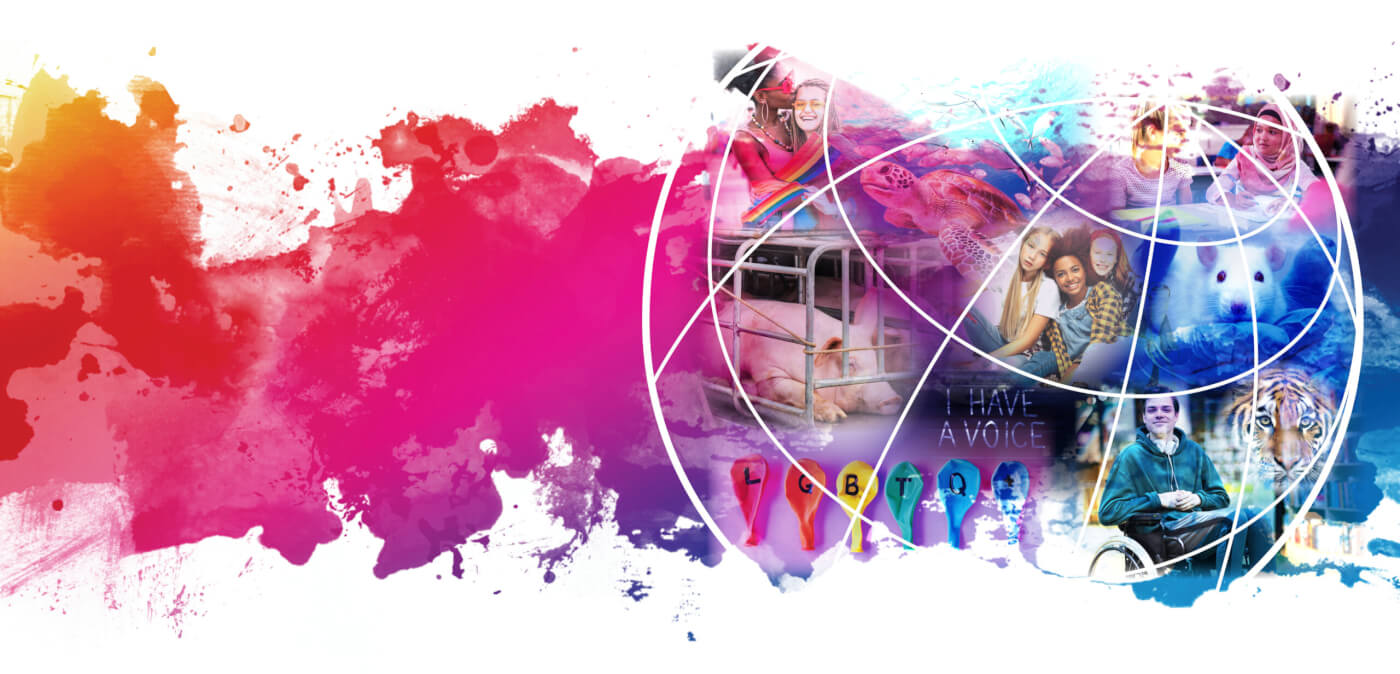Challenging Assumptions

Part 2 of Challenging Assumptions will take the bulk of the school year. You will continue to teach many of the same lessons you’re already teaching, using whatever standards are mandated in your state. In this section of the curriculum, we break the subjects of English language arts and social studies into broad themes, such as reading and writing and civics and economics, and provide recommended resources from our website along with suggestions from real classroom teachers for you to incorporate into your existing units of study. For example, our debate kits can be used in a writing unit about persuasive arguments or a research unit about evaluating sources.

ENGLISH LANGUAGE ARTS
Learning Objective: Read, comprehend, and analyze a variety of literary texts, including narratives, poetry, and drama.
The following activities can be integrated into existing English language arts lessons that address grade-specific Common Core Reading Standards for Literature in grades 9–12.
- Novel Study: Robin Lamont’s ‘The Chain’ From The Kinship Series
- National Poetry Month Activities: A Literary Celebration for Animals
Additional Suggestions
- When reading Harper Lee’s To Kill a Mockingbird, have students compare Atticus’ defense with recent legal arguments made for animal personhood.
- When reading William Golding’s Lord of the Flies, have students compare the treatment of the pigs with the killing of children.
- When reading Maya Angelou’s I Know Why the Caged Bird Sings, have students research the abuse of animals by humans and write their own “caged animal” poem modeled after Angelou’s poem “Caged Bird.“
- When reading Anna Sewell’s Black Beauty, have students analyze the use of the first-person perspective. Have them consider whether this affects the reader’s sense of the proper treatment of Black Beauty, horses, and animals in general.
Learning Objective: Read comprehend, and analyze a variety of informational texts, including speeches, biographies, and memoirs.
The following activities can be integrated into existing English language arts lessons that address grade-specific Common Core Reading Standards for Informational Text in grades 9–12.
- Host a Student-Led Book Club Based on PETA President’s Bestseller Animalkind
- Enough Is Enough: Current Events Lesson—Understanding COVID-19 and Preventing Future Zoonotic Diseases
- Activities: Other Animals Are Just Like Us
- Activities: Women in Leadership and Animal Rights
- Black History Month Activities: Celebrate Civil Rights Leaders Who Have Stood Up for Humans AND Other Animals
- From Sheep to Sweater—the True Cost of Wool
- TeachKind Rescue Stories
Additional Suggestions
When reading Narrative of the Life of Frederick Douglass, have students discuss how Douglass speaks at length about the dehumanization inherent in slavery and goes on to compare the treatment of humans with the treatment of animals.
Learning Objective: Apply knowledge of word origins, derivations, and figurative language to extend vocabulary development in authentic texts.
The following activity can be integrated into existing English language arts lessons that address grade-specific Common Core Standards for Language in grades 9–12.
Additional Suggestions
- When studying symbolism, have students discuss how attributing negative traits to certain animals can contribute to their being misunderstood, feared, and even abused. For example, the snake is often used as a symbol of evil in literature. Other common animal symbols include the crow (death), the fox (slyness), and the mouse (meekness).
- When studying connotation and denotation, have students discuss the negative connotations of words like “slither” and how they can be harmful to animals like snakes. Relate this to other social justice issues by discussing the negative connotations of the words “animal,” “black,” “queer,” etc.
Learning Objective: Write in a variety of forms, including narrative and expository, with an emphasis on persuasion.
The following activities can be integrated into existing English language arts lessons that address grade-specific Common Core Standards for Writing in grades 9–12.
Learning Objective: Analyze, evaluate, synthesize, and organize information from a variety of sources to produce a research product.
The following activities can be integrated into existing English language arts lessons that address grade-specific Common Core Standards for Writing in grades 9–12.
- Other Animals Are Just Like Us (‘Are We Really That Special?’ Activity)
- Research and Discussion Topics for High School Students
- ‘What’s a Vegan?’ Human-Supremacy Writing Activity
- Debate Kits
Additional Suggestions
Have students research the origins of a local tradition that harms animals (e.g., “possom drops“) or the problems with a local tourist attraction (e.g., roadside zoos) and write letters to authorities demanding change.
Learning Objective: Deliver informative and persuasive oral presentations.
The following activities can be integrated into existing English language arts lessons that address grade-specific Common Core Standards for Speaking & Listening in grades 9 -12.
Learning Objective: Participate effectively in a range of collaborative discussions with diverse partners.
The following activities can be integrated into existing English language arts lessons that address grade-specific Common Core Standards for Speaking & Listening in grades 9–12.
Learning Objective: Produce, analyze, and evaluate auditory, visual, and written media messages.
The following activities can be integrated into existing English language arts lessons that address grade-specific Common Core Standards for Speaking & Listening in grades 9–12 (i.e., interpret information presented in diverse media).
- Teaching With Film: Meet Scientists Who Choose Not to Experiment on Animals
- Teaching With Film: The Game Changers Discussion Questions
- Celebrate Earth Day by Saving Animals: Research and Poster-Making Project
- The Devil’s Dictionary: How Language Can Be Used for Good or Evil
Learning Objective: Evaluate sources, including advertisements, editorials, blog posts, websites, and other media for relationships between intent, factual content, and opinion.
The following activities can be integrated into existing English language arts lessons that address grade-specific Common Core Standards for Speaking & Listening in grades 9–12 (i.e., interpret information presented in diverse media).

SOCIAL SCIENCES
Learning Objective: Describe the development of social, political, economic, religious, and cultural patterns, including slavery, within and among various civilizations throughout history.
The following activity can be integrated into existing social studies lessons that address grade-specific National Curriculum Standards for Social Studies in grades 9–12.
- Have students trace the struggle for rights of different groups throughout history (e.g., Black Americans, women, the working class, Native Americans, immigrants, LGBTQ+, etc.). Have them research the fight for animal rights and compare it to these other issues. They could also research other countries that have embraced animal rights, such as Austria, and compare them to the U.S.
Learning Objective: Synthesize evidence from artifacts and primary and secondary sources to obtain information about events in history.
The following activities can be integrated into existing social studies lessons that address grade-specific National Curriculum Standards for Social Studies in grades 9–12.
- Enough Is Enough: Current Events Lesson—Understanding COVID-19 and Preventing Future Zoonotic Diseases
- Black History Month Activities: Celebrate Civil Rights Leaders Who Have Stood Up for Humans AND Other Animals
Learning Objective: Explain how indirect cause-and-effect relationships affect individuals, places, and events in history.
The following activities can be integrated into existing social studies lessons that address grade-specific National Curriculum Standards for Social Studies in grades 9–12.
- Enough Is Enough: Current Events Lesson—Understanding COVID-19 and Preventing Future Zoonotic Diseases
- Activities: Women in Leadership and Animal Rights
- Black History Month Activities: Celebrate Civil Rights Leaders Who Have Stood Up for Humans AND Other Animals
- ‘What’s a Vegan?’ Human-Supremacy Writing Activity
Learning Objective: Explain technological advances and transfers, networks of economic interdependence, and cultural interactions throughout history.
The following activities can be integrated into existing social studies lessons that address grade-specific National Curriculum Standards for Social Studies in grades 9–12.
Additional Suggestions
- Have students research the future of vegan meat, using TeachKind’s discussion questions for the documentary The Game Changers.
- Have students research replacements for animal dissection, using TeachKind’s resources on digital dissection.
- Have students explore vegan leather advancements and other vegan fabrics. This TeachKind lesson explores the lives of sheep used for wool and why it’s cruel to buy and wear wool.
- Have students research technological alternatives to using live animals for entertainment, such as at roadside zoos, in circuses, and at marine parks like SeaWorld as well as in film and television. You may have students use Google’s 3D and augmented reality search feature to demonstrate the quality of such technological alternatives.
Learning Objective: Identify social, economic, and ethical issues that affect certain regions of the world and propose solutions that equally consider individuals of different groups as well as the environment.
The following activities can be integrated into existing social studies lessons that address grade-specific National Curriculum Standards for Social Studies in grades 9–12.
Learning Objective: Apply civic virtues and democratic principles to make collaborative decisions.
The following activities can be integrated into existing social studies lessons that address grade-specific National Curriculum Standards for Social Studies in grades 9–12.
- When studying the philosophies of civil disobedience and nonviolent protest, provide students with examples of animal rights activists and organizations practicing them.
- When studying the Constitution and the U.S.’ status as a republic, have students evaluate the voting records of their representatives.
- Have students tune into PETA’s town hall meetings to learn about a variety of animal issues and how they can be resolved at the community level.
Learning Objective: Take knowledgeable, constructive action—individually and collaboratively—to address school, community, local, state, national, and global issues.
The following activities can be integrated into existing social studies lessons that address grade-specific National Curriculum Standards for Social Studies in grades 9–12.
- Captivity Kills: SeaWorld Exposed
- ‘Celebrate Earth Day by Saving Animals’ Research and Poster-Making Project
- What Winter Is Like When You’re a ‘Backyard Dog’
- Littering: Teach Students About Its Dangers to Animals
- Mother’s Day Activities: Let’s Celebrate Animal Moms, Too (Letters to SeaWorld Activity)
Learning Objective: Identify the rights and responsibilities of individuals and ethical use of materials and intellectual property.
The following activities can be integrated into existing social studies lessons that address grade-specific National Curriculum Standards for Social Studies in grades 9–12.
- Enough Is Enough: Current Events Lesson—Understanding COVID-19 and Preventing Future Zoonotic Diseases
- Unlearning Speciesism: A Lesson in Media Literacy
- From Sheep to Sweater—the True Cost of Wool
- Debate Kits
Additional Suggestions
Have students research and discuss recent legal arguments made for animal personhood.
Learning Objective: Analyze and explain the costs and benefits of a specific choice made, considering incentives and possible consequences.
The following activities can be integrated into existing social studies lessons that address grade-specific National Curriculum Standards for Social Studies in grades 9–12.
Learning Objective: Investigate and research to develop products orally and in writing.
The following activities can be integrated into existing social studies lessons that address grade-specific National Curriculum Standards for Social Studies in grades 9–12.
- Other Animals Are Just Like Us (‘Are We Really That Special?’ Activity)
- Research and Discussion Topics for High School Students
- ‘What’s a Vegan?’ Human-Supremacy Writing Activity
- Debate Kits
Additional Suggestions
Have students research and present on an accredited animal sanctuary anywhere in the world. Have them define what an accredited sanctuary is and what it is not and determine what is involved in starting and running one. Students may visit their chosen sanctuary in person or virtually.
Learning Objective: Construct informed, analytical arguments, using evidence from multiple sources to introduce and support substantive and significant claims.
The following activities can be integrated into existing social studies lessons that address grade-specific National Curriculum Standards for Social Studies in grades 9–12.
- Debate Kits
Learning Objective: Compare and contrast historical, cultural, economic, and political perspectives.
The following activities can be integrated into existing social studies lessons that address grade-specific National Curriculum Standards for Social Studies in grades 9–12.
- Have students research and present on the history of industrialized farming in the U.S.
- ‘What’s a Vegan?’ Human-Supremacy Writing Activity
- Have students research the economics of the vegan meat industry.
- Have students consider the ostracism of certain cultural or religious groups within schools because of practices such as animal dissection or default meat menus in school cafeterias. Have them explore the moral implications of such practices.
Learning Objective: Interpret charts, graphs, and pictures to determine characteristics of individuals, places, or events in history.
The following activity can be integrated into existing social studies lessons that address grade-specific National Curriculum Standards for Social Studies in grades 9–12.
Additional Suggestions
- Have students research and interpret the connection between human population growth and the extinction of other species, collecting samples of charts, graphs, and other informative graphics they find.
- Have students view and interpret a variety of infographics that focus on ways the populations of different species have changed as human civilization has advanced. What conclusions can they draw from these infographics?
Learning Objective: Critically evaluate the quality, accuracy, credibility, and validity of information to determine misconceptions, fact and opinion, bias, and propaganda.
The following activity can be integrated into existing social studies lessons that address grade-specific National Curriculum Standards for Social Studies in grades 9–12.

Special thanks goes to Alek Abate, Stephanie McLaughlin, Robyn Hicks, Mike Farley, Gail Frydkowski, and Nina Otazo—experienced classroom teachers who contributed their thoughts and ideas to this curriculum.
Looking for more ways to teach empathy for animals? Check out TeachKind’s free resources for students in grades 9–12:
